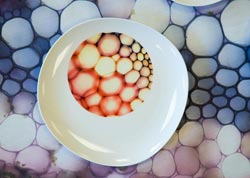The Art of Cell Division

"Jardim Porcelanico" by Rob Kesseler. Porcelain plate with printed decal of stem section of Chrysanthemum coronarium, stained with Safranin.<br>Copyright: Rob Kesseler, 2011<br>
The Integrating EU-project “MitoSys” is a major, multi-national research effort that aims to deepen our understanding of how cells divide. To make this project more accessible to the public, the scientists will be joined by artists of various disciplines who complement the research process.
MitoSys (systems biology of mitosis) is funded by the European Commission under its Seventh Framework (FP7) Programme. The 10 million Euro, five-year scientific project is a joint research effort, bringing together the expertise of thirteen European institutions and companies to generate a comprehensive mathematical understanding of mitotic cell division. The project is coordinated by Jan-Michael Peters, Senior Scientist and Deputy Director at the Research Institute of Molecular Pathology in Vienna. He has previously led the EU-project MitoCheck, which identified 600 genes involved in mitosis out of the 22,000 genes in the human genome and characterized the assembly of these mitosis genes into “molecular machines.”
Similar to MitoCheck, its follow-up project MitoSys will integrate the work of leading mathematicians, biochemists, biophysicists, biologists. This time, however, their efforts will be complemented by an ambitious outreach-project, involving internationally renowned artists from the genres of dance, ceramics, sculpture and fine arts. The project entitled “Meeting of Minds” is curated by Marina Wallace, director of Artakt at the University of the Arts in London.
The collaborators have been paired to form four couples, each involving a scientist who specializes in a particular aspect of mitosis and an artist as partner. The pairs meet regularly to gain insight into each other’s discipline and expertise. As a result of this interaction, four videos will be produced and incorporated into the documentary “Meeting of Minds”, elucidating the science explored and documenting the communication process. The screening of the film is part of an exhibition that will tour several European cities.
The pairings promise to deliver unique and diverse pieces of art: Geneticist Kim Nasmyth will be accompanied by experimental choreographer Shobana Jeyasingh. Cell biologist Tony Hyman is joined by artists Ackroyd & Harvey whose work includes sculpture, photography and architecture. Meiosis expert Melina Schuh will team up with Rob Kesseler, visual artist and Professor of Ceramic Art & Design at Central Saint Martins College of Arts and Design. Visual artists Lucy and Jorge Orta will interpret the work of cell-cycle expert Jan-Michael Peters.
“Artists and scientists have a lot in common,” says coordinator Jan-Michael Peters. “They are curious, creative and they are trained to cross borders. Even though we have completely different means of approaching our subjects, I have a feeling that we might all be driven by the same fundamental questions about the mechanisms of life.”
About MitoSys
MitoSys (systems biology of mitosis) started in June 2010 and will last until 2015. Its aim is to tackle mitosis from a systems biology perspective. Leading biologists, mathematicians, biochemists and biophysicists working at thirteen research institutes, universities, international organizations and companies in eight European countries collaborate to reveal how genes and proteins orchestrate mitosis in human cells. MitoSys will receive ten million Euros from the European Union under its seventh framework programme (FP7).
About Jan-Michael Peters
Jan-Michael Peters was born in Heide, Germany, in 1962. He studied Biology in Kiel and Heidelberg and in 1991 obtained his PhD in Cell Biology. As a postdoctoral fellow, Peters worked with Werner Franke at the German Cancer Research Center in Heidelberg and later in Marc Kirschner’s lab at the Harvard Medical School in Boston. In 1996, Jan-Michael Peters joined the IMP in Vienna. He has received a number of awards for his research on cell division, including the EMBO Young Investigator Award, the Novartis Research Prize and the Wittgenstein Award by the Austrian federal government.
About the IMP
The Research Institute of Molecular Pathology (IMP) in Vienna is a basic biomedical research institute largely sponsored by Boehringer Ingelheim. With over 200 scientists from 30 nations, the IMP is committed to scientific discovery of fundamental molecular and cellular mechanisms underlying complex biological phenomena. Research areas include cell and molecular biology, neurobiology, disease mechanisms and computational biology. The IMP is a founding member of the Campus Vienna Biocenter.
Contact
Dr. Heidemarie Hurtl
IMP Communications
Tel.: (+43 1) 79730 3625
hurtl@imp.ac.at
Media Contact
More Information:
http://www.imp.ac.atAll latest news from the category: Life Sciences and Chemistry
Articles and reports from the Life Sciences and chemistry area deal with applied and basic research into modern biology, chemistry and human medicine.
Valuable information can be found on a range of life sciences fields including bacteriology, biochemistry, bionics, bioinformatics, biophysics, biotechnology, genetics, geobotany, human biology, marine biology, microbiology, molecular biology, cellular biology, zoology, bioinorganic chemistry, microchemistry and environmental chemistry.
Newest articles

Silicon Carbide Innovation Alliance to drive industrial-scale semiconductor work
Known for its ability to withstand extreme environments and high voltages, silicon carbide (SiC) is a semiconducting material made up of silicon and carbon atoms arranged into crystals that is…

New SPECT/CT technique shows impressive biomarker identification
…offers increased access for prostate cancer patients. A novel SPECT/CT acquisition method can accurately detect radiopharmaceutical biodistribution in a convenient manner for prostate cancer patients, opening the door for more…

How 3D printers can give robots a soft touch
Soft skin coverings and touch sensors have emerged as a promising feature for robots that are both safer and more intuitive for human interaction, but they are expensive and difficult…





















